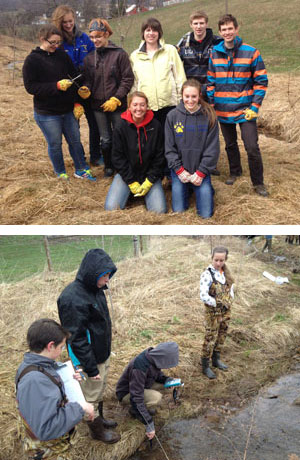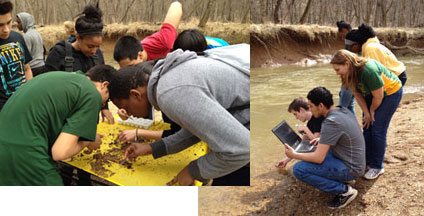Two teachers of DuVal High School took their students outdoors to study the health of Still Creek, in Greenbelt. Their plan is to investigate the health of their stream and then take action to help improve these conditions over time.
Baden Elementary School
The 5th and 6th graders at Baden Elementary conducted their first annual "Stream Investigation". We are anxious to compare our data each year and use hands on learning to improve the water quality of Black Swamp Creek. We are so thankful for a mini grant from Chesapeake Bay that enabled us to purchase all our needed supplies to get started. As we continue to do more to be stewards of the earth we will also integrate these activities in our annual "Arbor/Earth Day" school wide activities in order to incorporate all grades to actively participate in our school's Explore and Restore project.
Conowingo Elementary School
Conowingo Elementary involved their whole school in addressing their schoolyard's impact on their local stream. Kindergarten through 5th grade investigated erosion, habitat, and native vegetation for their area, used art, community outreach, and technology to learn about their environment, and built a rain garden.
Sudbrook Magnet School
At Sudbrook Magnet Middle 7th grade students added plants to their school's rain garden to lesson the impact their schoolyard has on their local stream. Other students created infographics on the importance of rain gardens and the garden’s connection to the Villa Nova Park section of the Gwynn’s Falls.
Roland Park Country School
At Roland Park Country School the sixth grade participated in the Explore and Restore Project during the 2013-2014 year. Students were involved in “rainwater walks” on campus, stream studies in the woods, and planning and constructing a model rain garden for a playhouse. Most classes were held outdoors in the school yard where students develop a sense of place and use a problem-solving, active learning approach.
North Garrett High School

Top: AP Environmental Science Teacher Rebecca Kenyon-Sisler with her students at their restoration project on Cove Run.
Bottom: Students from North Garrett County High School mentoring students from Swan Meadow on how to measure water quality.
Mrs. Kenyon-Sisler and her students worked over 2 years with land-owners, community partners, and a DNR Biologist to fence off large tracts of pasture land to restore a riparian buffer. These students planted trees and other plant species to increase the shade over the stream which, two years later, has allowed many macroinvertebrates, birds and small mammal species to re-colonize the area.
Seneca Valley High School

Seneca Valley High School students working at their local stream with IB Science teacher Elaine Shute.
These students have made 2 trips to their local stream, Great Seneca Creek, to measure water quality indices and identify macroinvertebrates. They have become pros at collecting chemical data and Mrs. Shute is contemplating an action project with next year’s students to help reduce erosion along the banks.